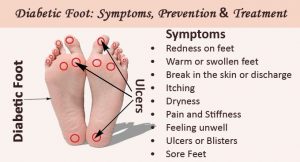Diabetic Feet: 10 Smart Tips for Keeping Them Safe
Major problems, including as ulcers, infections, and numbness or discomfort, are far more common in diabetics. I’ve covered this topic extensively in past blogs.
10 Diabetic Footcare Tips That Are Easy To Follow

1. Examine your feet on a daily basis. This is arguably the most crucial but also the most basic guideline. Examine the entire foot, including the bottom, from ankle to toes. If you can’t see the bottom, get the help of someone you trust, or take a picture with a mirror or a cell phone camera. In the office, I frequently take images with my phone to show patients abnormalities on the bottom of their feet that they can’t see. I can show close-ups and expand sections with the camera. The camera on your phone is a fantastic tool. Look for red regions, calluses, cracks in the skin, new lesions, and any changes in general, as well as white patches or cracks between the toes. Any bleeding should be immediately reported to your doctor or podiatrist.
2. Soak your feet in warm, but not hot, water every day. Because these areas are frequently ignored, wash and thoroughly dry between your toes. There are several places where threads and fluff might hide, causing irritation and friction. Furthermore, because these spaces are dark and secluded, they are ideal breeding grounds for germs and fungi. Check the water temperature with your hands first, as your feet may not be able to detect extremely hot water. Use your elbow if your fingers are numb. Soaking your feet on a regular basis might cause the skin to dry out.
3. Don’t cut your toenails yourself. It is generally preferable to have your nails trimmed by someone else. It’s fine if your nails are normal and you have someone at home who can cut them for you. If not, have them clipped by a specialist, such as a podiatrist. If they’re thick or malformed, you should absolutely have them cut by a podiatrist. Any other difficulties or prospective problems can be identified and treated early by getting your nails clipped by a podiatrist. Your nails should always be clipped straight across and not too short by whoever trims them. This will keep your nails from becoming ingrown, which can cause a variety of uncomfortable issues.
4. Never, ever use a sharp object to cut calluses or remove skin growths. It’s a recipe for disaster to use sharp devices on your own foot. It’s quite easy to cut oneself and get an infection. Diabetic foot infections are more difficult to treat, and they can result in significant consequences and hospitalizations. Use caution when using over-the-counter wart and callus removers, as they often include acid, which can cause foot burns. A medical practitioner, generally a podiatrist, should treat any calluses. Before any skin lesions are cut off, they must be thoroughly assessed by a specialist.
5. Moisturize your feet every day, particularly before bedtime so that the lotion can absorb in. Diabetic feet are frequently dry as a result of nerve damage to the sweat glands. Dry skin is more prone to cracking and is less able to withstand tension. I recommend a petroleum-based, non-scented moisturizer, such as ointment. In severe circumstances, your practitioner may recommend prescription-strength moisturizers. It’s better to apply the moisturizer before going to bed because it lasts all night. Moisturizers should not be used between the toes. Always dry the flesh between your toes since moisture can collect there and cause fungus or bacterial infections.
6. Walking barefoot is never a good idea. Many diabetics’ feet have little or no sensation. When you’re barefoot, it’s easy to walk on anything alien and injure your foot. When walking barefoot, another concern arises. It’s simple to injure the toes and foot by slamming them against objects like furniture, resulting in wounds and shattered bones. Stepping on an item that gets into the bottom of the foot can cause significant limb-threatening illnesses. Diabetics have a hard time fighting infections and, in many situations, recuperate slowly. If you don’t want to wear your “outside” shoes indoors, invest in a decent pair of supportive slippers that provide the same level of comfort and protection as orthopedic shoes. I strongly recommend IDEASTEP slippers since they include an orthotic insole, customizable cushioning, and numerous adjustable options.
7. Maintain a healthy blood sugar level. Elevated blood sugar/glucose can aggravate or cause neuropathy. Numbness or a loss of feeling in the feet can be caused by neuropathy. The single most dangerous symptom of diabetes on the feet is a loss of feeling. Ulcers, infections, and amputation are all possible outcomes. Furthermore, as blood sugar levels rise, it becomes more difficult to prevent infections because the white cells that fight infection become less effective. Maintain a well-balanced diet and track your blood sugar levels on a regular basis.
8. Never, ever, ever, ever, Smoking is harmful to the entire body, especially the feet. By the sensation of a person’s feet, I can always tell if they smoke in my workplace. Smoking constricts the blood vessels in the feet, especially the toes, resulting in cold toes in almost all smokers. Smokers have a harder difficulty healing cuts on their feet and are more susceptible to infection. In smokers, the big blood arteries in the legs frequently occlude, resulting in amputations.
9. Put on correct shoes and insoles, especially extra-deep diabetic shoes. Diabetic shoes should come in a variety of widths, up to extra extra wide, to avoid rubbing and excessive pressure on wide feet. Diabetic insoles or orthotics should be able to fit in them. The upper, whether leather or cloth, should be comfortable, and the interior should be padded and smooth, with no seams to prevent skin irritation. Even better, 4-way stretch fabric clings to the curves of your foot shape and provides a pressure-free environment. To accommodate common toe deformities like bunions and hammertoes without rubbing the toes, the toe box should be high and wide. IDEASTEP, a leading manufacturer of orthopedic footwear, focuses in producing styles for diabetic and neuropathic feet. They have a large selection of diabetic shoes for men and women in sizes up to 6E.
The shoes should be worn with insoles. A top layer of pink soft material that conforms to the foot and offloads any bumps is common on diabetic insoles. For support, the insole should have a slight arch. IDEASTEP produces insoles and doctor-prescribed insoles that are specifically designed for diabetes. They have a molded arch support and a deep heel cup to assist stabilize the foot and reduce stress on the feet, ankles, and knees. Their soft cushioning foam dynamically moulds to the curves of the foot, absorbing stress and relieving pressure on the bottom of the foot.

10. Put on the correct socks. You might think that because socks are soft, they are all suitable for diabetic feet, but this is not the case. Cotton socks should be avoided because they trap moisture against the feet and keep them wet. Polypropylene or genuine wool are preferable synthetic fibers. IDEASTEP makes diabetic socks made of bamboo that are comfortable and wick moisture away from the feet. Furthermore, socks with tight tops that grab the leg and induce constriction around the lower leg, leaving markings, should be avoided. Diabetic socks should be stretchy but not too tight around the leg. Diabetic socks from IDEASTEP are also distinguished by a white sole, which is critical for diabetics. This can warn the wearer to new ulcers, blisters, or sores that they may not have seen due to their neuropathy.
Finally, diabetes affects the majority of people for the rest of their lives. It is manageable. I have never had a diabetic patient lose a foot in my 31 years of practice. As a podiatrist, I work with patients to safeguard their feet through education and medical treatment. Above all, the ten diabetic foot care suggestions are beneficial.
